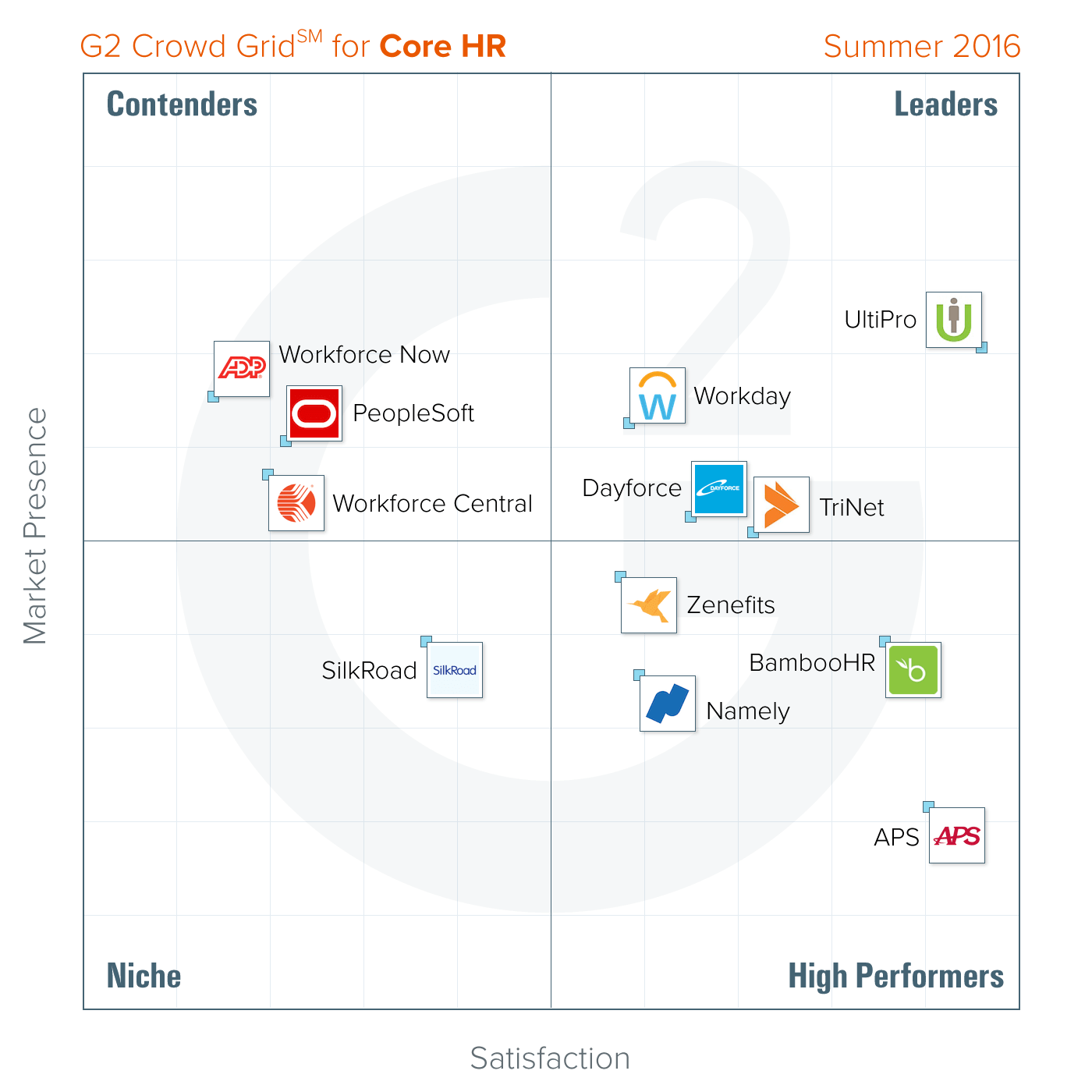Your business will always have competition.
And if you don’t know what that competition is up to, you could be missing out on huge opportunities.
That’s why a competitive analysis is so crucial to your success as a business. It gives you the tools to quickly adapt to any changes in the competitive landscape and potentially capitalize on industry trends that your competitors haven’t even noticed.
So let’s get some basics out of the way…
Why use a competitive analysis template?
To start off, here’s a competitive analysis template you can use to organize your research, compare competitors and present key insights effectively:

A competitive analysis template streamlines your research, making your report more structured and impactful. Here’s why it’s a smart choice:
- Saves time – Pre-formatted sections let you focus on insights, not design.
- Ensures thorough analysis – Covers key areas like competitor strengths and market gaps.
- Provides structure – Keeps data organized for easy readability and decision-making.
Competitor analysis examples with templates
Let’s delve into some competitor analysis examples that can empower your organization to navigate the market effectively.
1. Competitor analysis example for marketing specialists
Imagine this: You are a Marketing Specialist and your goal is to establish a strong online presence and attract a diverse user base. However, you face stiff competition from established players in the market. Here are some things you should look into when doing your competitor analysis:
Competitor analysis focus:
- SEO strategies: Analyze competitors’ websites to understand their SEO strategies. Identify high-ranking keywords, backlink strategies, and content optimization techniques. Alternatively, if you’re running a local business, you might want to analyze and scrape Google Maps listings to better assess how companies are optimizing Google My Business to generate leads. When doing so, it’s crucial to web scrape without getting blocked by using proper techniques like rotating IPs and handling request limits carefully.
- Social media engagement: Examine competitors’ social media presence. Evaluate the type of content that garners engagement, the frequency of posts, and audience interactions.
- Online advertising: Investigate competitors’ online advertising campaigns. Are they leveraging Google Ads, social media ads, or other platforms? Assess the messaging, visuals, and targeting criteria.
- Content marketing: Scrutinize competitors’ content marketing efforts. Identify the topics that resonate with their audience, the formats they use (blogs, videos, infographics), and the platforms they prioritize.
Here’s a SWOT analysis template to help you get started:
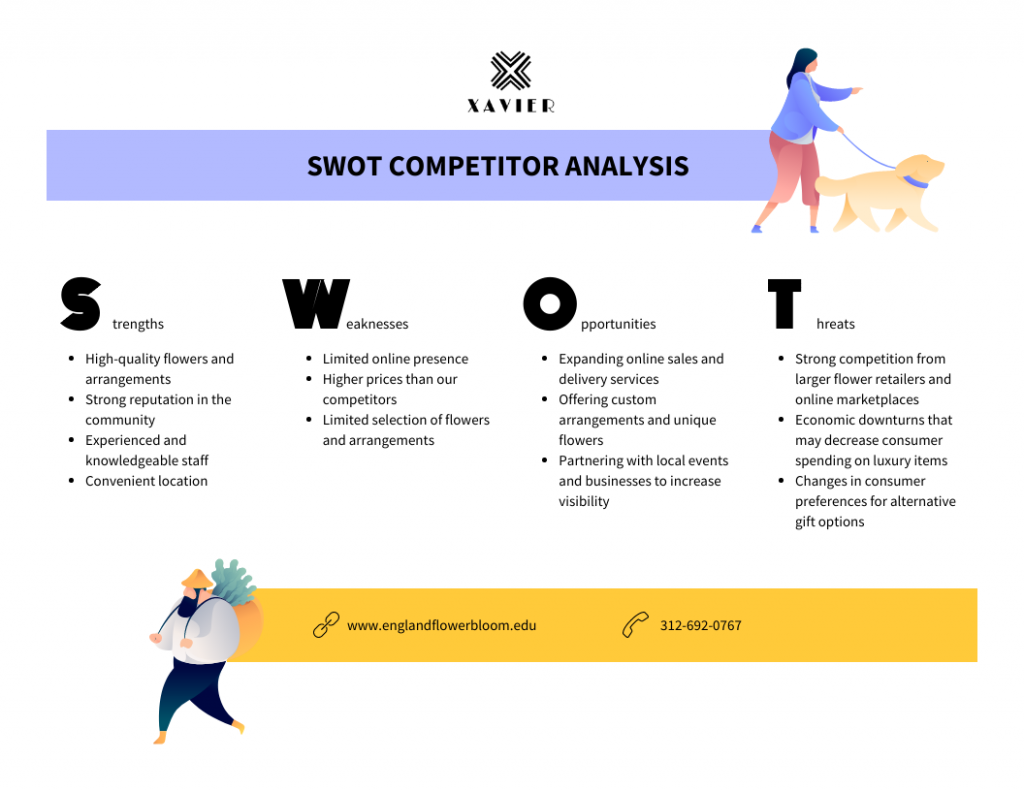
2. Competitor analysis example for SME business development managers
Imagine this: As the business development manager for a medium sized start up, you are tasked with expanding the client base. The market is crowded with similar service providers, and differentiation is key. When doing your competitor analysis report, look into:
Competitor analysis focus:
- Client testimonials and case studies: Explore competitors’ websites for client testimonials and case studies. Identify success stories and areas where clients express satisfaction or dissatisfaction.
- Service offerings: Analyze the range of services offered by competitors. Identify gaps in their offerings or areas where you can provide additional value to clients.
- Pricing models: Investigate competitors’ pricing structures. Are they offering packages, subscription models, or customized solutions? Determine whether there’s room for a more competitive pricing strategy.
- Partnerships and collaborations: Explore potential partnerships or collaborations that competitors have formed. This can provide insights into untapped markets or innovative service delivery methods.
Here’s a competitor analysis comparison chart template that you could use:
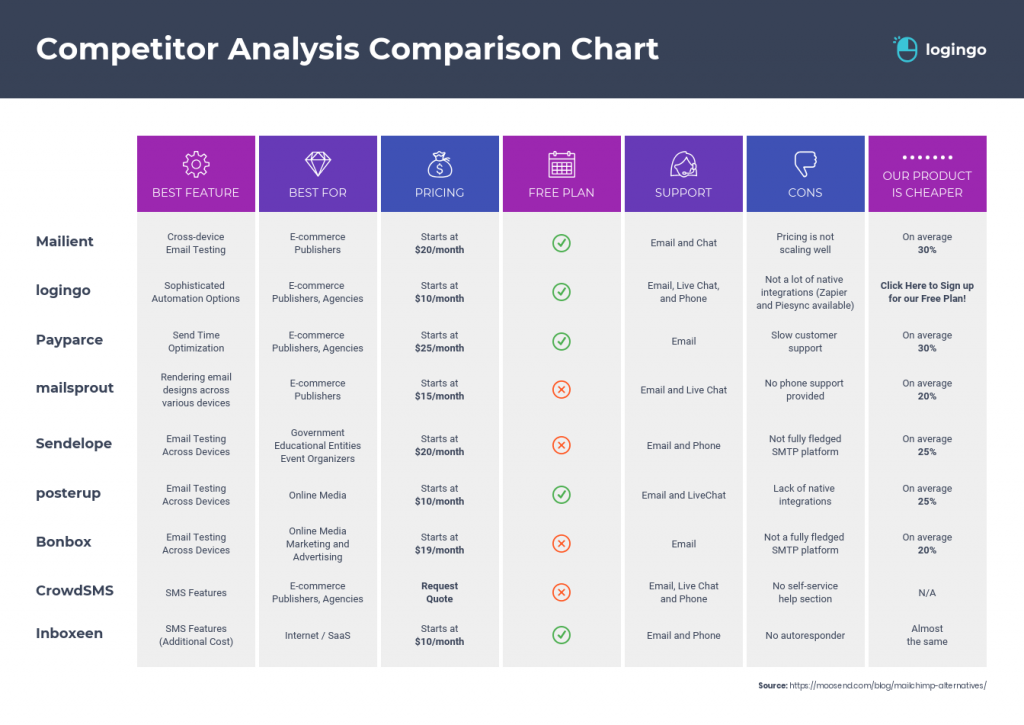
3. Competitor analysis example for product managers
Imagine this: You are a Product Manager for a consumer electronics company tasked with improving your company’s products and services. The market is buzzing with innovation, and staying ahead requires a deep understanding of competitor products.
Competitor analysis focus:
- Feature comparison: Conduct a detailed feature-by-feature comparison of your product with competitors. Identify unique features that set your product apart and areas where you can enhance or differentiate.
- User experience (UX): Use a UX research tool to evaluate the user experience of competitors’ products. Analyze customer reviews, app ratings, and usability feedback to understand pain points and areas for improvement.
- Technological advancements: Investigate the technological capabilities of competitors. Are they integrating AI, IoT, or other cutting-edge technologies? Assess whether there are emerging technologies you can leverage. One example could be using advanced AI technologies, such as LangChain custom tools, to build AI-powered applications like chatbots and virtual agents that you can implement
- Product lifecycle management: Examine competitors’ product release cycles. Identify patterns in their product launches and assess whether there are opportunities for strategic timing or gap exploitation.
To help you get started, use this competitive analysis report template to identify the strengths, weaknesses, opportunities and threats of the product or service
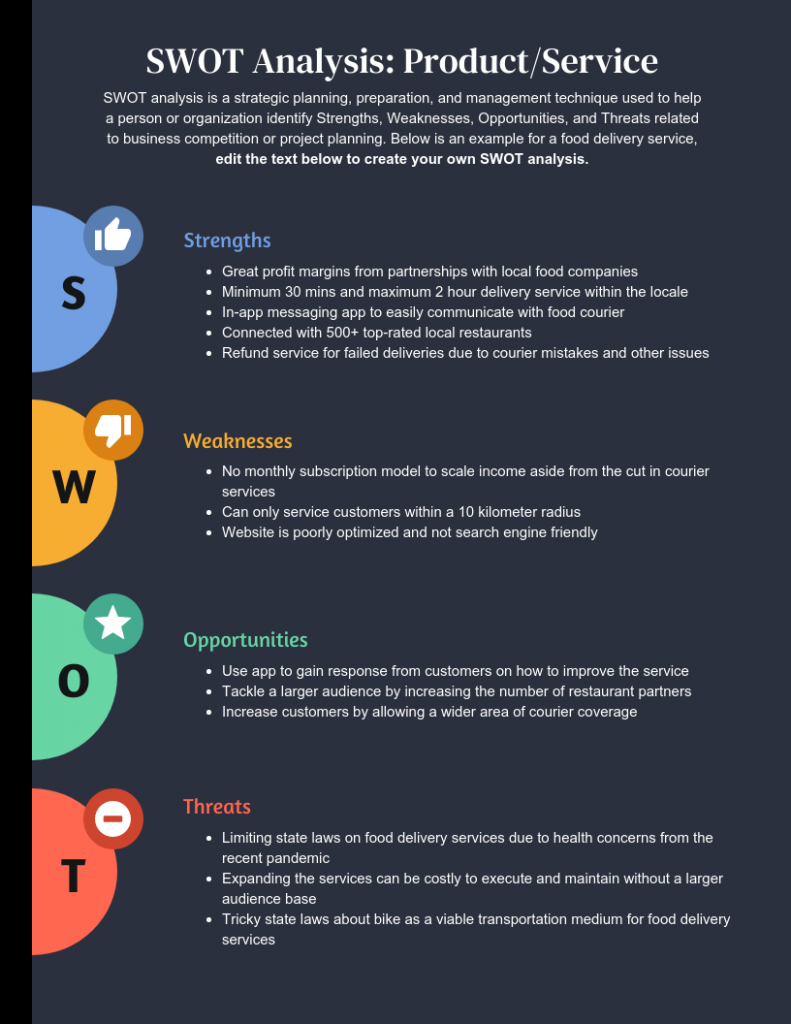
What is a competitive analysis report?
A competitive analysis report outlines the strengths and weaknesses of your competitors compared to those of your own business.
Typically, a competitive analysis report will contain:
- A description of your business’s target market
- Details about the features of your product compared to your competitors’ products
- A breakdown of current and projected market share, sales, and revenues
- Comparisons of pricing models
- An analysis of marketing strategy and social media strategy
- A description of customer ratings of the features of each competitor
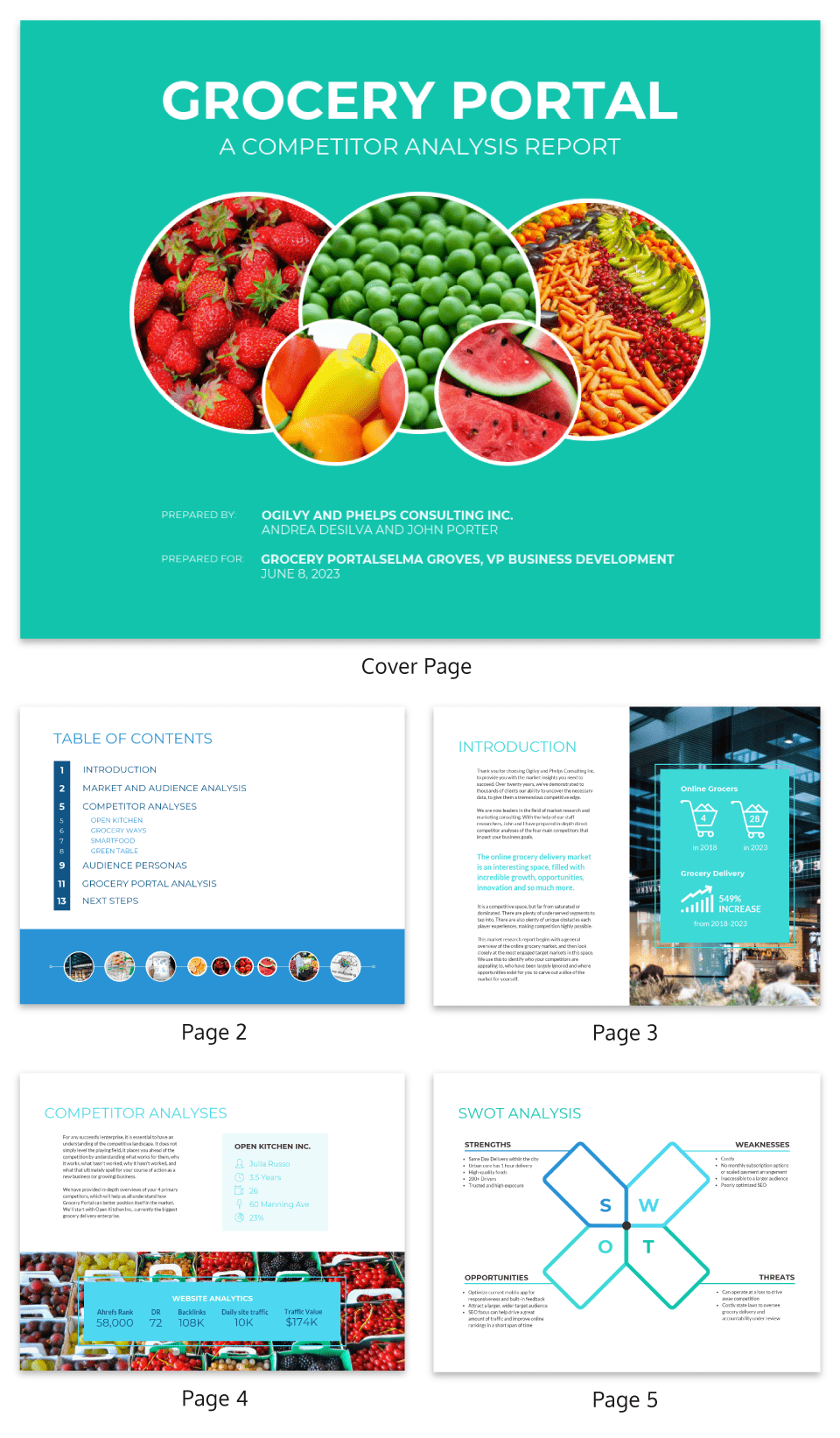
Whether you’re a startup trying to break into the marketplace, a consultant trying to get results for your client, or an established company looking to cement your foothold against the competition, a well-researched competitive analysis gives you the tools you need to make strategic decisions.
Your competitive analysis should inform your marketing plan, your business plan, your consultant report and every part of your high-level business strategy.
But how do you actually create a competitive analysis report?
Types of competitor analysis
Competitor analysis can take a few different forms depending on what you’re trying to uncover. Each one looks at a slightly different angle of the market and pulls in its own set of data.
Direct vs. indirect competitor analysis
- Direct competitors: Offer the same or very similar products to help you understand immediate threats and customer alternatives.
- Indirect competitors: Solve the same problem in a different way, highlight emerging trends and shifts in customer behavior.
Product vs. marketing vs. sales analysis
- Product analysis: Compares features, pricing, UX and overall value.
- Marketing analysis: Looks at SEO visibility, social media activity, content strategy and ad campaigns.
- Sales analysis: Reviews messaging, funnels, demos and outreach tactics to understand how competitors convert leads.
Strategic vs. tactical analysis
- Strategic analysis: Focuses on long-term direction like market share, positioning and major investments.
- Tactical analysis: Examines short-term actions like promotions, ad copy, content topics and rapid product updates.
And because each approach looks at the market from a different angle, they also rely on different data. Marketing analysis often pulls from search rankings, engagement metrics and content audits, while product analysis leans on pricing pages, feature breakdowns and hands-on product reviews.
How to make a competitor analysis report?
The level of detail you include in each section of your competitive analysis report will vary depending on the stage of your business growth and your goals. For example, a startup might create a report that focuses on market research, while an established business might dive into detail on an emerging competitor.
But let’s talk about the parts of a competitive analysis that every report should include.
- Start with a competitor overview
- Conduct market research to uncover customer personas and industry trends
- Analyze marketing channels & content
- Compare product features in a feature comparison matrix
- Assess sales processes & customer feedback
- Summarize your strengths and weaknesses with a SWOT analysis
- Show where you fit in the competitive landscape
- Use a competitor analysis template for a professional look and feel
1. Start with a competitor overview
A strong report shows exactly what a company must out-compete to be successful.
Meaning you must audit any product or service that currently solves the problem your business is trying to solve for customers and write a quick profile for each competitor.
Like the template below, each competitor profile might include:
- The company’s revenue and market share
- The company’s size and information about their management team
- A broad description of the company’s strengths and weaknesses
- An overview of how the company is perceived by customers
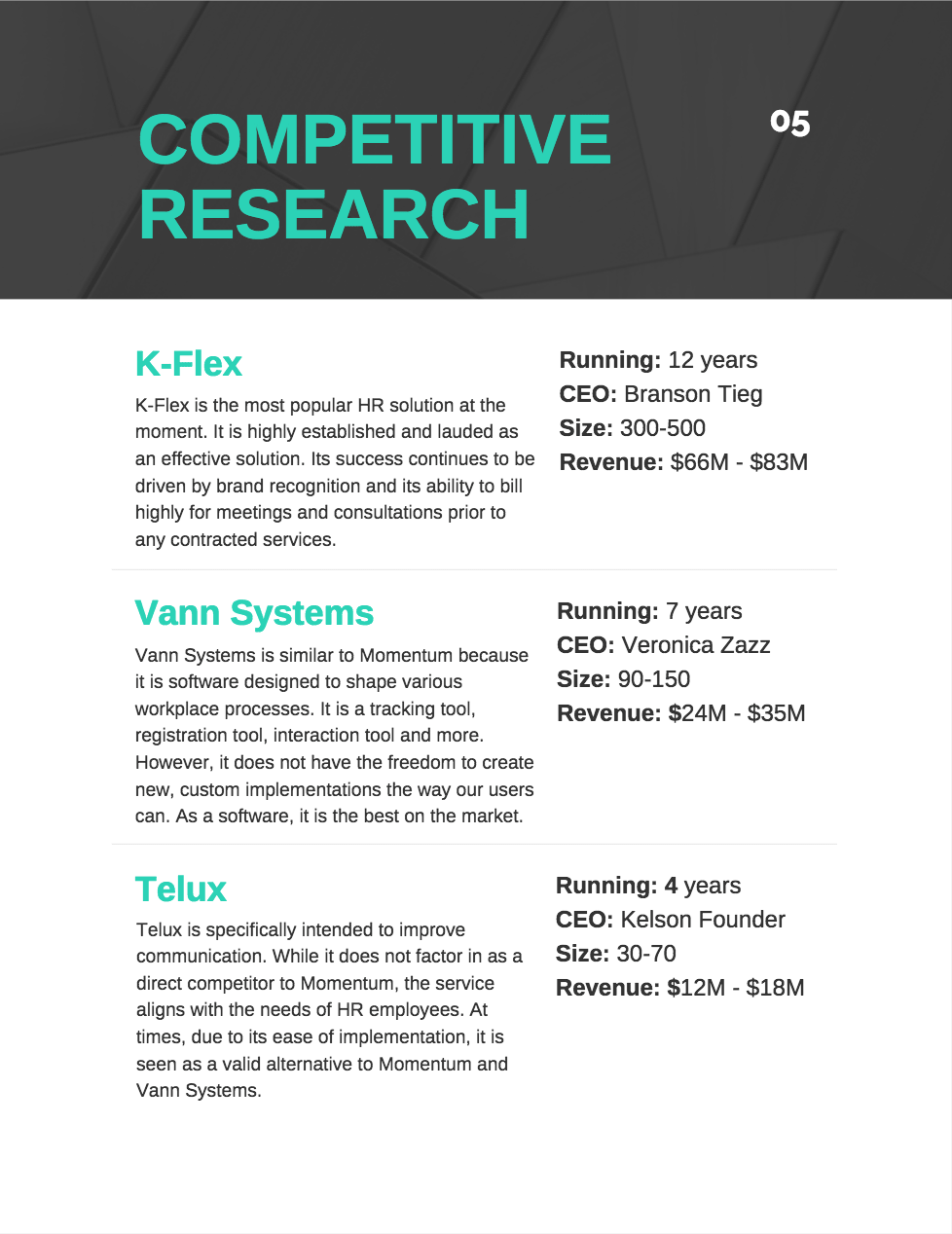
This overview will help your readers get a big-picture view of the market landscape.
2. Conduct market research to uncover customer personas and industry trends
You can’t create a competitive analysis report without doing extensive market research, which is all about gathering information to understand your customers, identify opportunities to grow, and recognize trends in the industry.
This research can help you put together the customer personas that will guide business and marketing decisions down the line, and allow you to plan for any shifts that might disrupt the marketplace.
You can conduct primary market research, with:
- Customer interviews
- Online surveys or questionnaires
- In-person focus groups
- Purchasing a competitor product to study packaging and delivery experience
Or secondary market research, by:
- Reading company records
- Examining the current economic conditions
- Researching relevant technological developments
When assembling your market research you may just want provide a high-level summary of the industry trends, like this competitor analysis example shows:
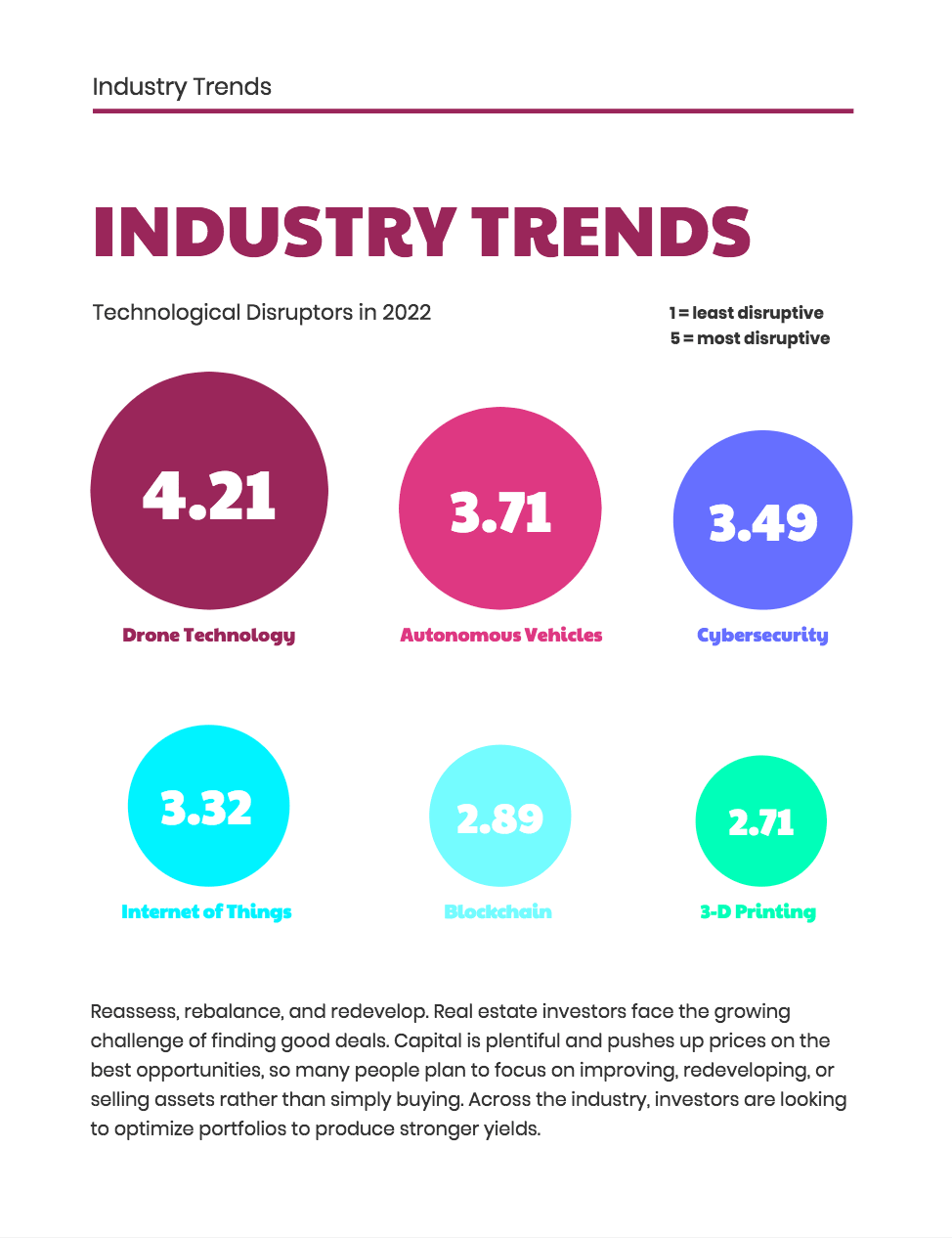
Or you may want to dive into detail on the demographics of a particular consumer segment, like this:
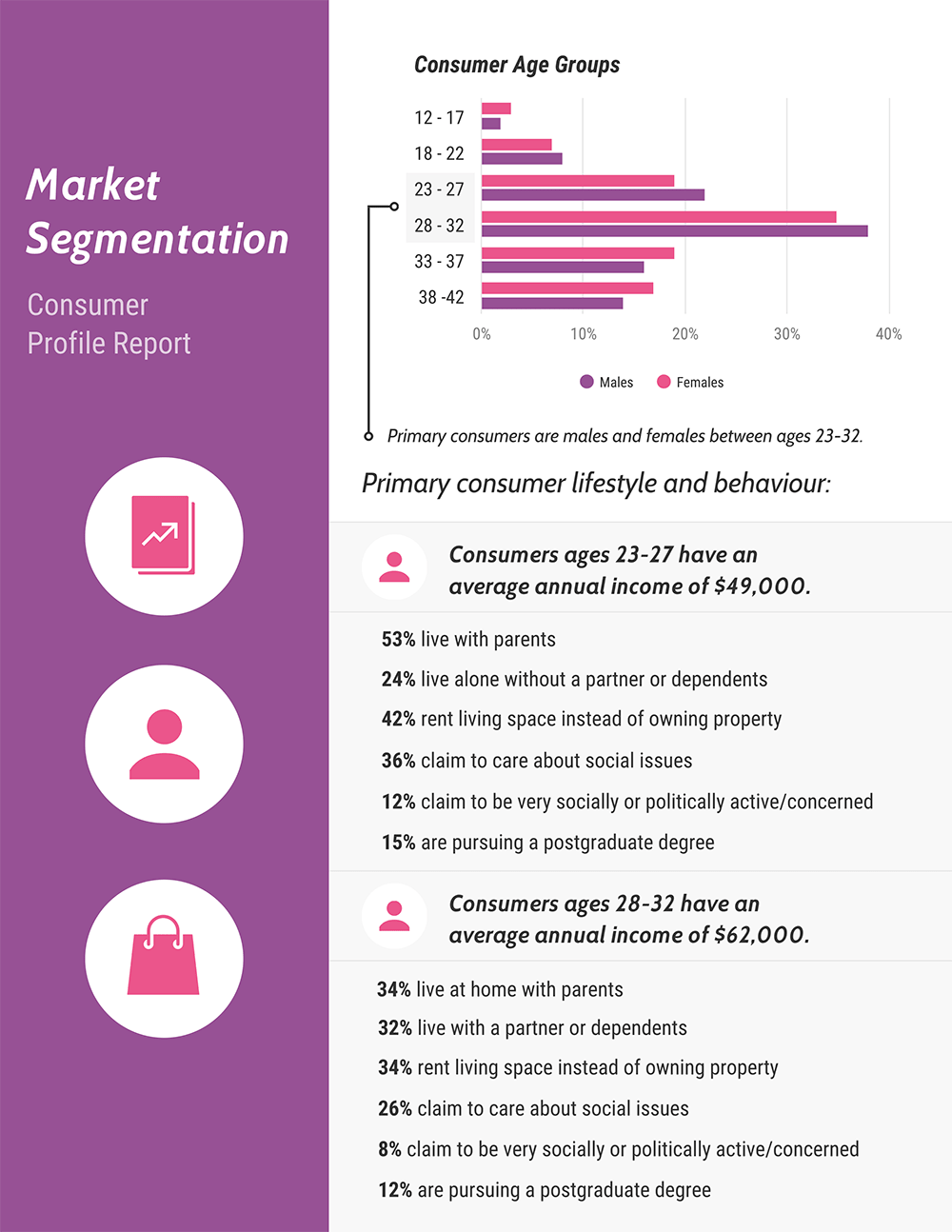
But if you’re a consultant or advisor struggling to get buy-in from skeptical stakeholders, the report below would be ideal. Covering everything from market forecasts to consumer profiles, it can help you get clients and decision-makers on board.
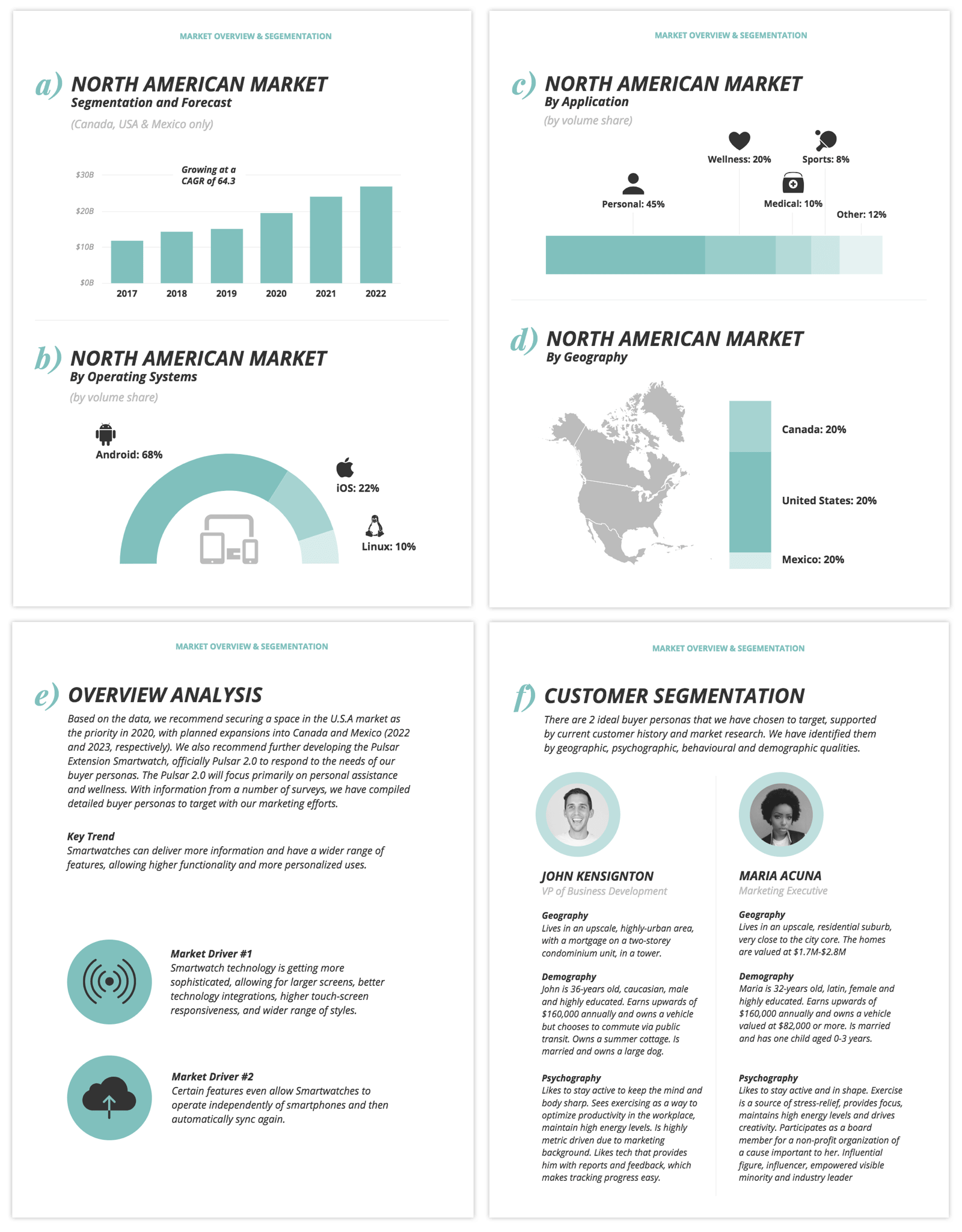
3. Analyze marketing channels & content
Understanding how competitors show up online helps you see which channels drive their visibility and engagement. Reviewing their marketing activity gives you insight into what formats resonate with your shared audience and where there may be opportunities to outperform them.
When analyzing marketing channels, look at areas like:
- SEO performance (rankings, keywords, backlink quality)
- Social media activity and engagement
- Content formats (blogs, videos, carousels, guides, webinars)
- Publishing frequency and consistency
- Ad campaigns and messaging themes
The most common approach is to map out each competitor across these channels and note how active, consistent and effective they are.
Useful resources for this section include SEO tools (Ahrefs, SEMrush), social media analytics tools and content libraries. They’ll help you understand not only what your competitors publish but how well it performs.
4. Compare product features in a feature comparison matrix
The feature comparison is arguably the most important part of the competitive analysis. Breaking down your product and your competitors’ products feature-by-feature will allow you to see what really sets everyone apart.
In addition to specific product features, here are some attributes that you might include in a feature comparison matrix:
- Price
- Service
- Product quality
- Number of features
- Ease of use
- Warranties
- Customer support
- Brand/style/image
The most common format for a features analysis is a simple matrix with you and your competitors along one side and all of the relevant features along the other. You can check off or rate how you perform in each area:
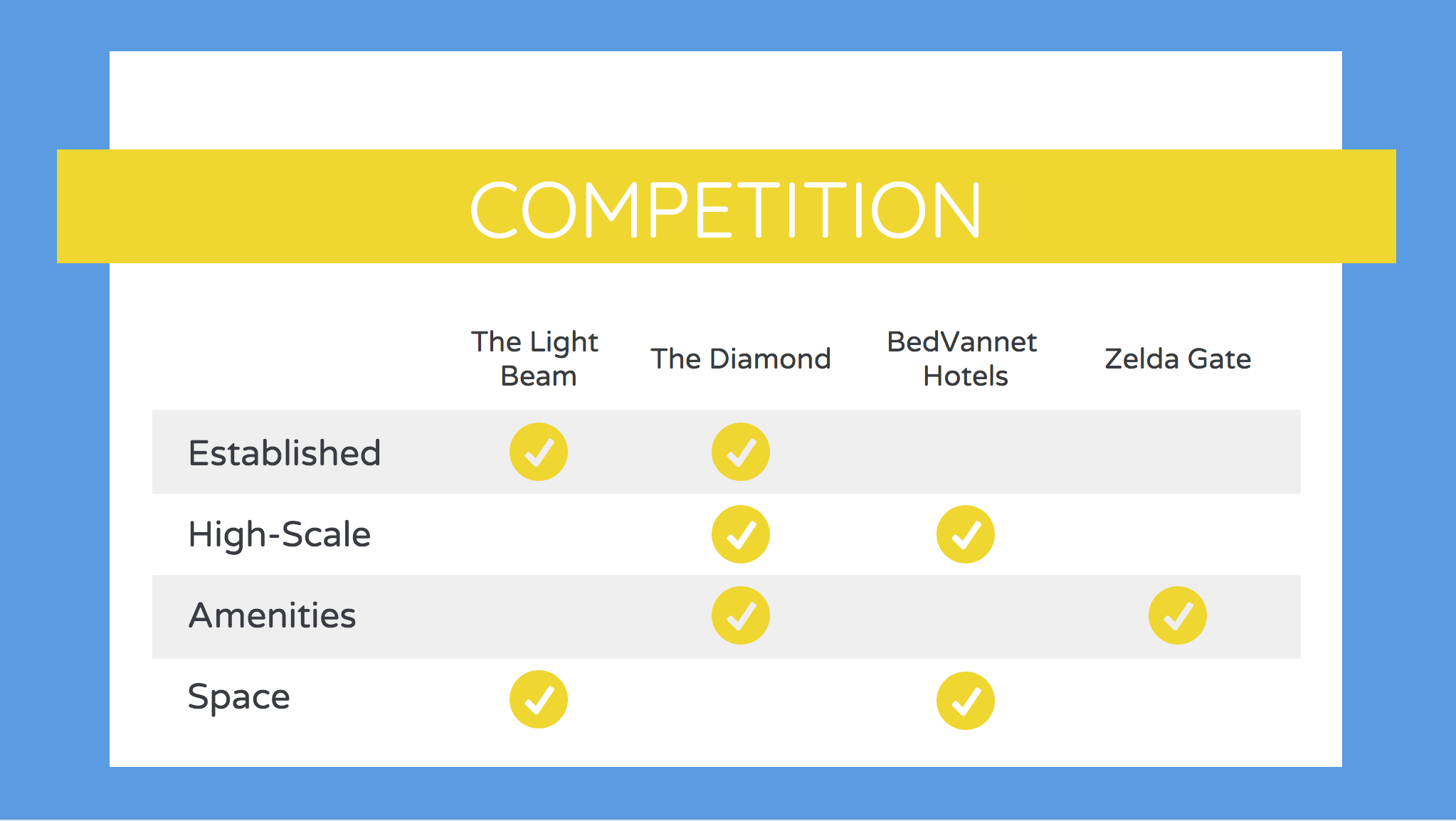
But these tables can get pretty long. Another approach is to focus on the things that provide the most value to the user, like in this competitor analysis example from Mint. It only includes ease of use, costs, and benefits:
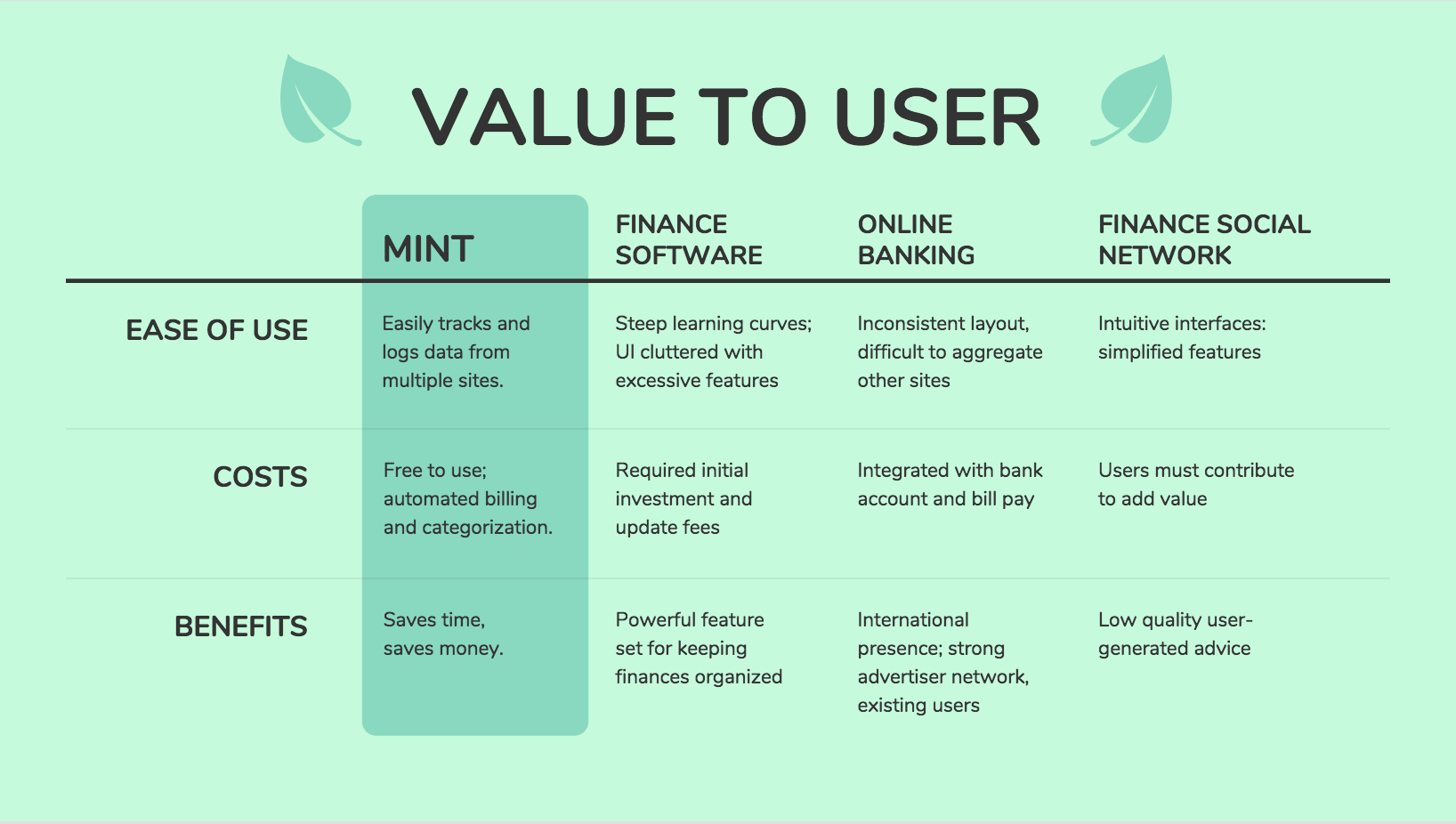
If you want to visualize your comparisons in an engaging way, you could use a comparison infographic.
Great resources for this section of your competitive analysis report are product rating sites like Capterra and G2Crowd. They’ll give you an unbiased view of your company and your competitors.
And as with any market research, it’s critical that you speak with real people who use your product and your competitors’ products. That’s the only way to get an accurate picture of how your target customers rate the competition.
5. Assess sales processes & customer feedback
Evaluating competitors’ sales processes gives you a clearer idea of how they convert interest into revenue. And pairing that with real customer feedback helps you uncover gaps, strengths and frustrations that people consistently experience.
Key elements to assess include:
- Sales funnels and how leads move from awareness to purchase
- Messaging used in demos, emails and onboarding
- Pricing models, discounting and packaging
- Customer support experience
- Trial processes, guarantees and refund policies
A structured way to do this is to map each competitor’s funnel and annotate strengths, friction points and unique approaches.
For customer insights, platforms like G2, Capterra and Trustpilot are especially valuable. They offer unfiltered reviews that highlight recurring complaints, praised features and patterns in user sentiment.
As with any competitive research, pairing online feedback with real conversations makes your findings much stronger. Talking to customers who have switched from or to your competitors will give you context that no data tool can offer.
6. Summarize your strengths and weaknesses in a SWOT analysis
When you’re conducting research for your competitive analysis, it’s going to be messy. You’ll have a lot of data and it’ll be hard for an outsider to understand.
That’s what makes the SWOT analysis so essential.
A SWOT analysis is a framework for evaluating your competitive position by listing your key strengths, weaknesses, opportunities, and threats.
It can act like a short summary of the rest of your competitive analysis report for anyone who doesn’t have time to dig into the details.
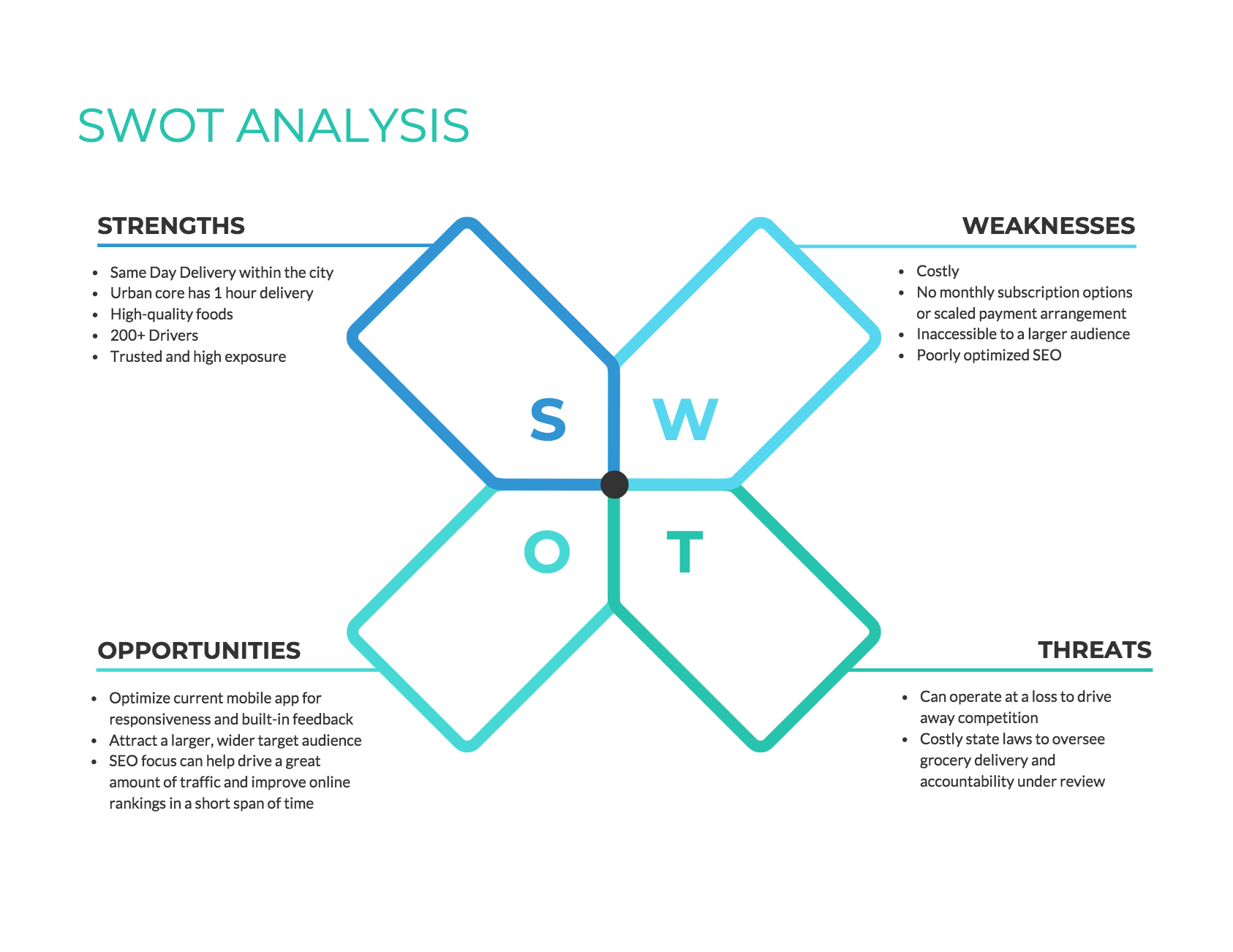
Click the template above to enter our online SWOT analysis maker tool. Customize the template to your liking–no design no-how required.
Here are some questions to kickstart your SWOT analysis:
- Strengths: What are we doing really well (in terms of marketing, products, sales, branding, technology, etc.)?
- Weaknesses: What are we struggling with? What’s holding us back?
- Opportunities: What’s the weakest area for our biggest competitor? Are there any gaps in the market that aren’t current being addressed? What has recently changed in our business or the market?
- Threats: What is our biggest competitor doing much better than us? What new products/features are they working on? What problems aren’t we currently addressing?
In your report, you could arrange your SWOT analysis in a simple list, but it can be helpful to use color-coded quadrants, like the competitor analysis example below. Note how each quadrant is paired with an icon:
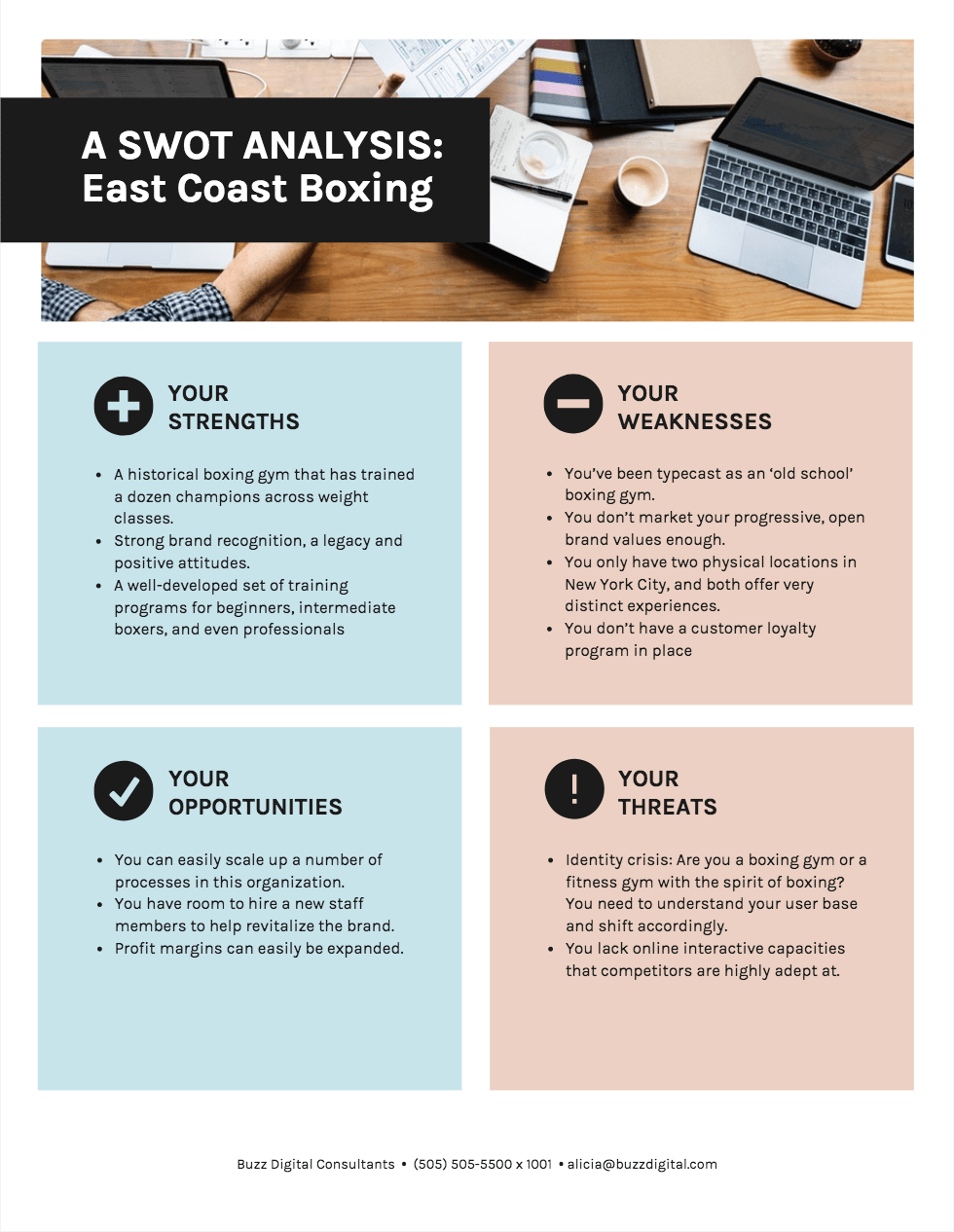
7. Show where you fit in the competitive landscape
After summarizing your strengths, weaknesses, opportunities, and threats, it’s time to look at the bigger picture. It’s time to figure out where every major competitor currently fits into the competitive landscape.
The most popular way of doing this is to identify the two dimensions that are most important for being competitive in your industry and plot them on a matrix, like this one from the Boston Consulting Group:
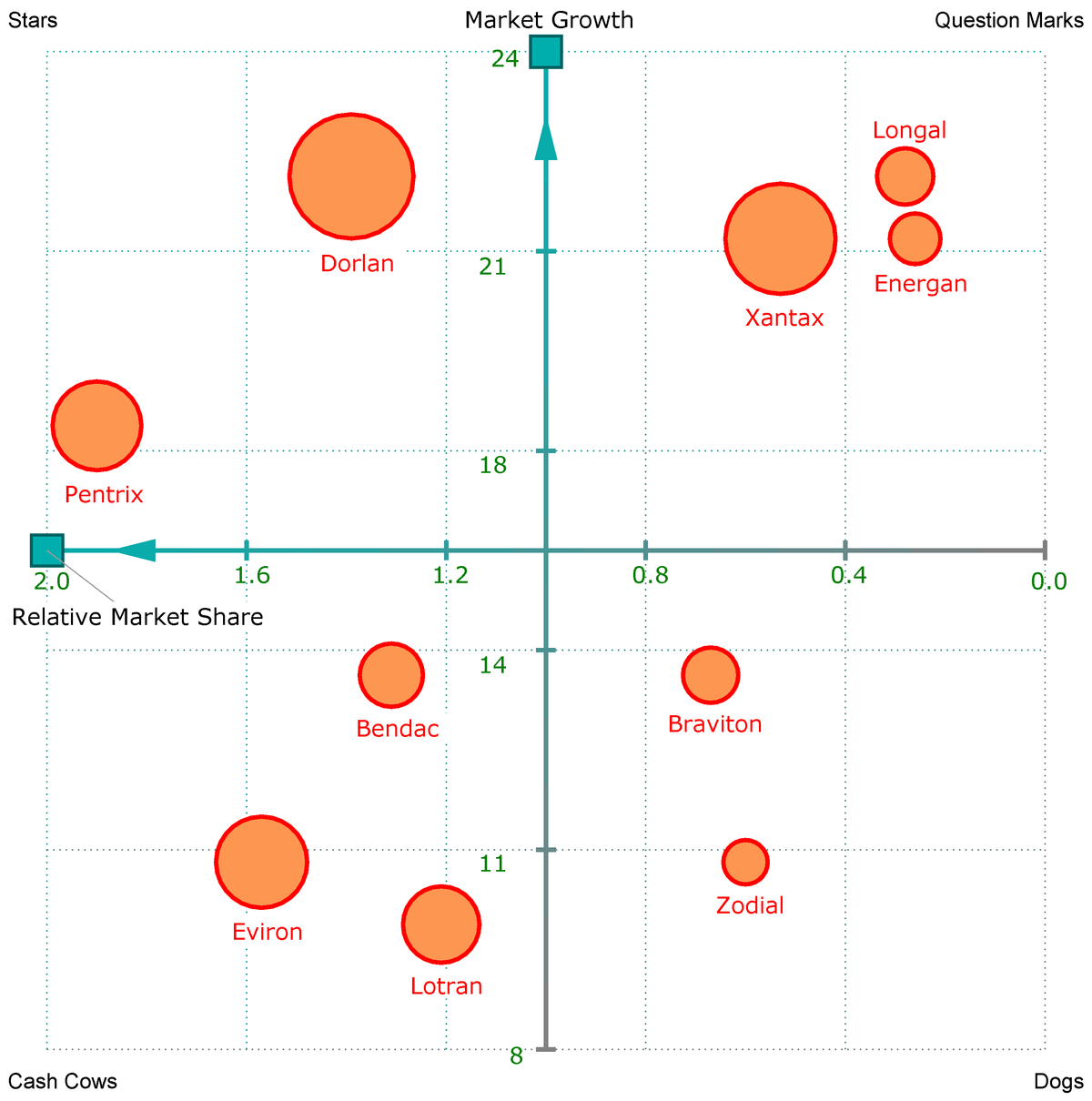
And this one from G2 Crowd (which looks at market presence and customer satisfaction):
You may want to focus on where you fit in the market landscape based on your own biggest strengths and weaknesses, or the biggest threats and opportunities you identified in the SWOT analysis.
Or, it may be enough just to summarize in words the features and benefits that set your apart from your competitors (which is a great way to end your report on a high note).
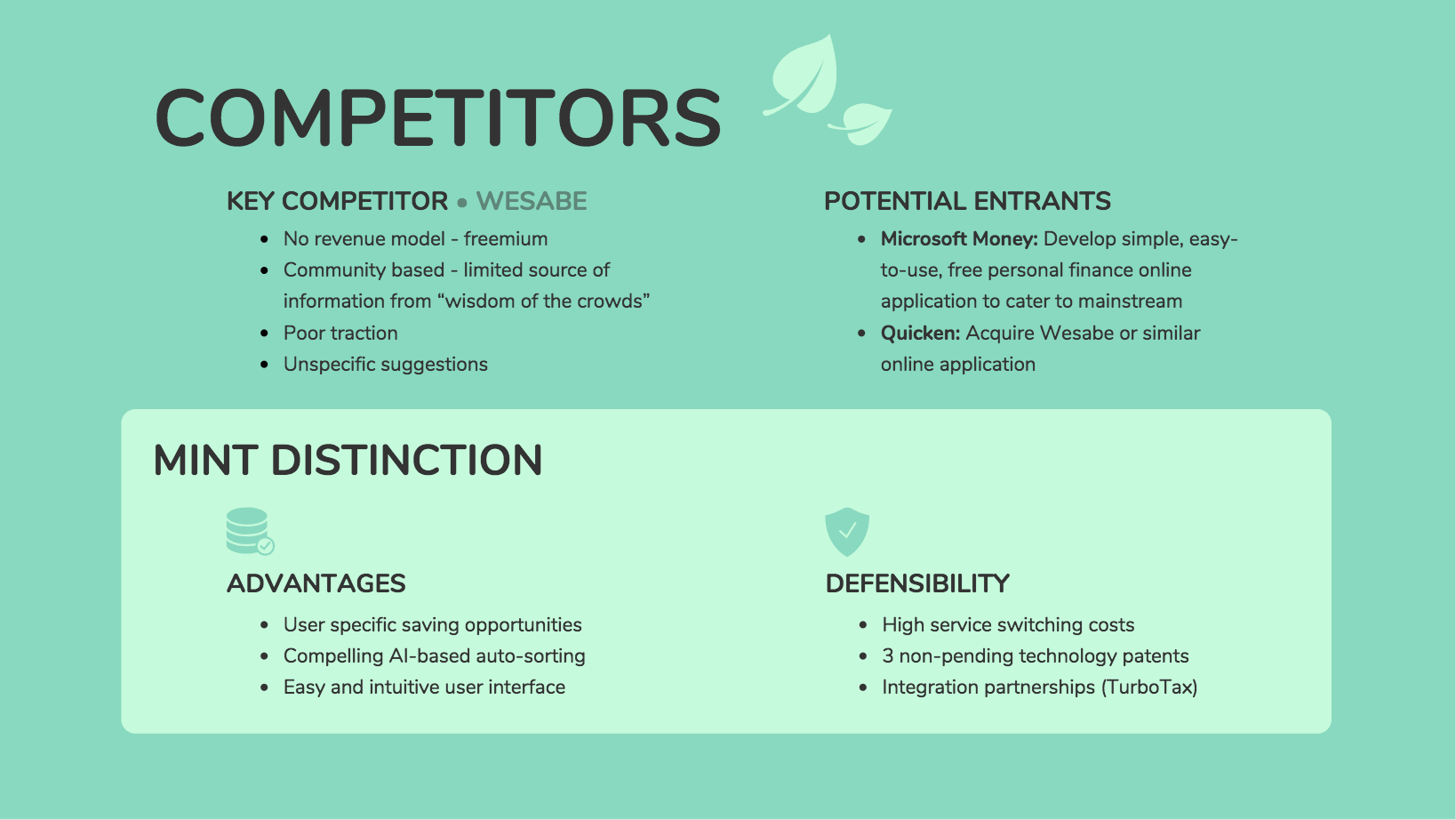
Tools for Competitor Analysis
A good set of tools can make your competitor research far more accurate and easier to explain. Here are some reliable options to help you gather data, spot patterns and present your findings clearly.
- Venngage: Venngage is great for turning raw research into clean, professional visuals. You can build comparison tables, charts and full reports that make your insights easier for teams and stakeholders to understand.
- SEMrush: SEMrush helps you explore competitors’ SEO performance, keyword strategy, backlink profile and paid search activity. It’s especially useful when you want to see where competitors are gaining visibility and where they aren’t.
- Ahrefs: Ahrefs offers deep insight into backlinks, top-performing pages and competitor content. It’s a dependable tool for figuring out which topics drive traffic for others in your space and where you might have opportunities to rank.
- Similarweb: Similarweb provides a broad view of competitor traffic, audience behavior, referral sources and top pages. This helps you understand which channels bring them the most attention.
- BuzzSumo: BuzzSumo shows which competitor content performs best across platforms. You can see what formats people engage with, which topics gain traction and who’s amplifying their content.
- BuiltWith: BuiltWith uncovers the tools and technologies powering competitors’ websites, from CMS to analytics to marketing systems. It’s helpful for understanding their capabilities and evaluating tools you may want to adopt.
- Google Alerts: A simple but reliable way to track brand mentions, competitor news, PR updates and new content. Setting alerts saves time and keeps you updated without manual monitoring.
Using these tools together gives you a more complete picture of your competitive landscape and makes your final report stronger, more credible and much easier to share.
How to present a competitor analysis
Presenting a competitor analysis effectively involves organizing and communicating information about your competitors in a clear and concise manner. Here’s a step-by-step guide on how to present a competitor analysis:
- Introduction: Start with a brief introduction to set the stage. Outline the purpose of the competitor analysis and its significance in the current market context.
- Competitor identification: Clearly list and identify the main competitors. Include both direct and indirect competitors. Briefly describe each competitor’s core business and market presence.
- Key metrics and performance: Present key metrics and performance indicators for each competitor. This may include market share, revenue, growth rate, and any other relevant quantitative data.
- SWOT analysis: Conduct a concise SWOT analysis for each competitor. Summarize their strengths, weaknesses, opportunities, and threats. Use a simple visual representation if possible.
- Market positioning: Discuss how each competitor is positioned in the market. This could include their target audience, unique selling propositions, and any specific market niches they occupy. Also, focus on finding keywords, as your competitor’s targeted keywords are the main source of information on their online market performance.
- Strategic moves: Highlight recent strategic moves made by your competitors. This could include product launches, partnerships, mergers, acquisitions, or changes in pricing strategy. Discuss how these moves impact the competitive landscape.
- Recommendations and implications: Based on the analysis, provide recommendations and implications for your company. Identify opportunities to capitalize on competitors’ weaknesses and outline potential threats that need to be addressed. Discuss any adjustments to your own strategy that may be necessary in response to the competitive landscape.
3 tips to improve your competitive analysis report design
A well-designed competitive analysis report isn’t just nice to look at—it helps stakeholders quickly grasp key insights and take action. Here’s how to make your report clear, engaging, and professional.
1. Start with a competitor analysis template
A cluttered, unstructured report can hurt your credibility. A competitor analysis template, like the one below, gives you a polished design from the start, so you can focus on the content instead of worrying about layouts and formatting. Just tweak it to fit your needs—no design skills required.
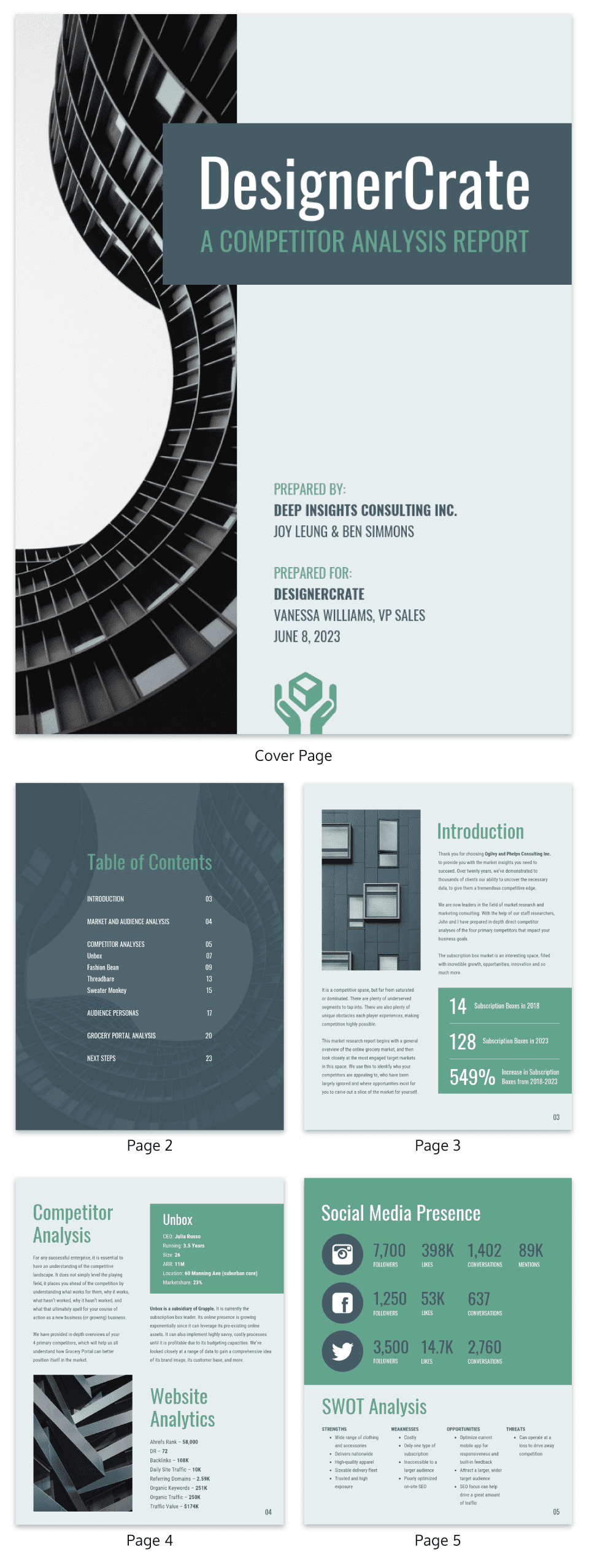
2. Keep core design elements like colors and fonts consistent
A messy mix of fonts, colors, and visuals makes reports harder to follow. Keeping things consistent like in the example below helps readers scan for key insights and makes your report look more professional.
A few quick tips for keeping important design elements consistent::
- Stick to one color scheme, with a highlight color for key takeaways.
- Limit font styles to 2-3 for headers and body text.
- Use one style of visuals—either flat icons or illustrated, not both.
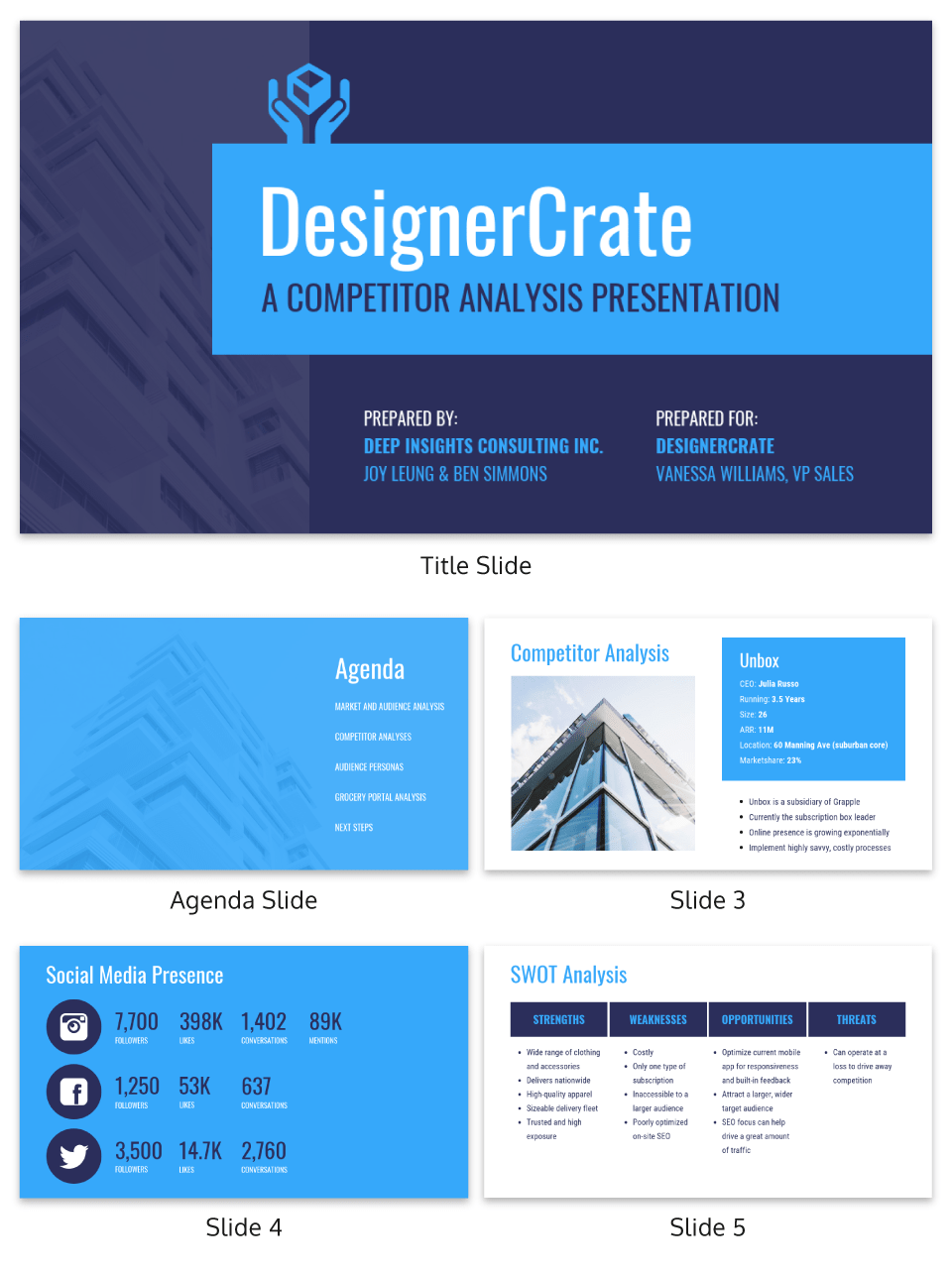
3. Use visuals to summarize important information and keep your audience engaged
Lengthy text blocks can overwhelm readers. Instead, incorporate charts, tables and well-spaced lists to make data digestible and engaging.
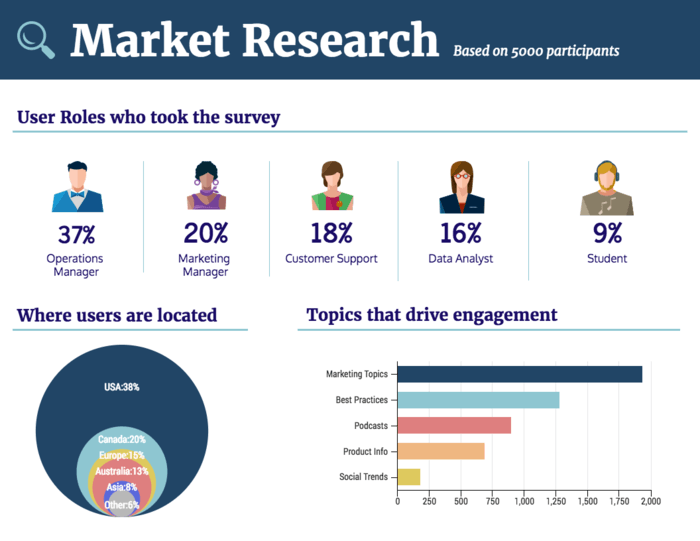
The more you replace text with visuals, the easier it is for stakeholders to grasp your findings. Here’s an example you can refer to:
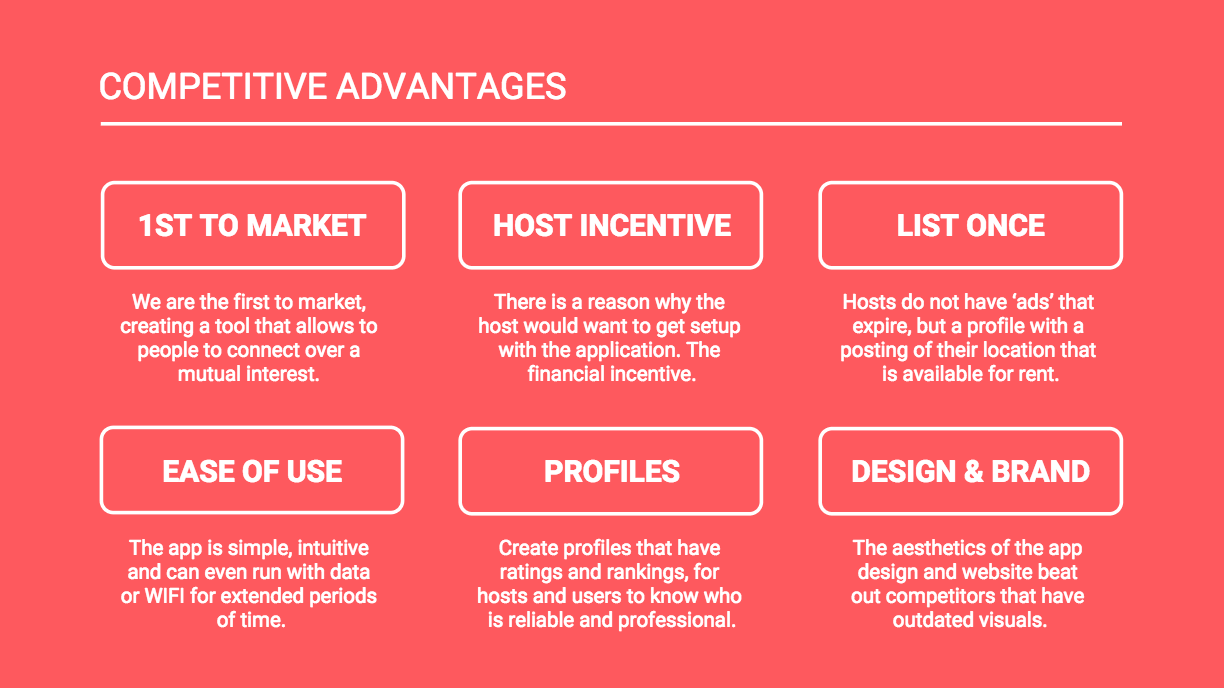
Competitor analysis FAQs
How long should a competitor analysis report be?
Most competitor analysis reports fall between 5–15 pages. The ideal length depends on your goals, but prioritize clear insights, visual summaries and actionable findings rather than long descriptions.
How often should you update your competitor analysis?
A quarterly update works for most businesses. In faster-moving industries, review competitors monthly or whenever major changes occur, such as new product launches, pricing updates or shifts in customer behavior.
Conclusion
A competitive analysis will allow you to think up effective strategies to battle your competition and establish yourself in your target market.
And a report that communicates the findings of your competitive analysis will ensure stakeholders are on board and in the know.
Now that you know how to design a competitive analysis report, you’re ready to get started:




























